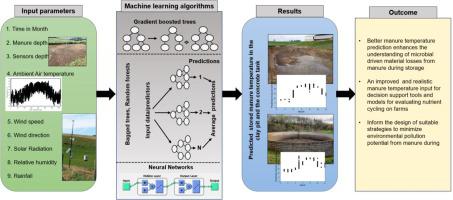Computers and Electronics in Agriculture ( IF 8.3 ) Pub Date : 2021-06-07 , DOI: 10.1016/j.compag.2021.106234 Rana A. Genedy , Jactone A. Ogejo

|
There is no standard method to predict manure temperature during storage. So, decision support tools, on-farm nutrient cycling models, and life cycle assessment tools to assess the sustainability of agricultural production systems that include manure typically use ambient air temperature as a surrogate for manure temperature. This study explores the application of machine learning algorithms' unique abilities to predict manure temperature based on measured data. The data was collected from two on-farm manure storages (clay pit and concrete tank) instrumented with sensors to acquire manure temperature at various depths during the storage period. The local weather data (ambient air temperature, wind speed, wind direction, solar radiation, relative humidity, and rainfall) were recorded by stations installed at each farm. The data were subjected to four machine learning algorithms gradient boosted trees, bagged tree ensembles, random forest ensembles, and neural networks using the supervised learning approach. The weather data and two additional parameters, time (month) and the manure depth above a sensor, were derived and used as inputs for the machine learning algorithms. Further, the developed machine learning algorithms were challenged with parameters from historical weather data (1990 to 2020) to assess their suitability to predict manure temperature where local weather is not available.
The results showed that, in general, the stored manure temperature lagged but followed a similar trend as the ambient air temperature and solar radiation. The average manure temperature was higher than the ambient air temperature for most of the year. Depth influenced the manure temperature; manure in the top layers had a higher temperature during warm periods than the bottom layers, and vice versa during cold seasons. The ensemble models performed better than the neural networks by predicting manure temperatures closer to the measured values and predictions during the scenario analysis. The random forests and bagged tree ensembles were the best performers. Models tended to make better predictions as the depth of manure above a sensor increased. This work will provide added value for developing better decision support tools and models for assessing nutrient cycling on farms. It also informs our knowledge to develop emission mitigation strategies during manure storage, leading to more sustainable manure management practices.
中文翻译:

使用机器学习技术预测储存期间的液态乳粪温度
没有标准方法可以预测储存期间的粪便温度。因此,用于评估包括粪便在内的农业生产系统可持续性的决策支持工具、农场养分循环模型和生命周期评估工具通常使用环境气温作为粪便温度的替代指标。本研究探讨了机器学习算法在基于测量数据预测粪便温度方面的独特能力的应用。数据是从两个农场粪便储存库(粘土坑和混凝土罐)收集的,这些储存库装有传感器,可在储存期间获取不同深度的粪便温度。当地天气数据(环境气温、风速、风向、太阳辐射、相对湿度和降雨量)由每个农场安装的站点记录。数据经过四种机器学习算法:梯度提升树、袋装树集成、随机森林集成和使用监督学习方法的神经网络。天气数据和两个附加参数,时间(月份)和传感器上方的粪便深度,被导出并用作机器学习算法的输入。此外,开发的机器学习算法受到来自历史天气数据(1990 年至 2020 年)的参数的挑战,以评估它们在当地天气不可用的情况下预测粪便温度的适用性。被派生并用作机器学习算法的输入。此外,开发的机器学习算法受到来自历史天气数据(1990 年至 2020 年)的参数的挑战,以评估它们在当地天气不可用的情况下预测粪便温度的适用性。被派生并用作机器学习算法的输入。此外,开发的机器学习算法受到来自历史天气数据(1990 年至 2020 年)的参数的挑战,以评估它们在当地天气不可用的情况下预测粪便温度的适用性。
结果表明,一般而言,储存粪便温度与环境空气温度和太阳辐射温度滞后但趋势相似。一年中的大部分时间,平均粪便温度高于环境空气温度。深度影响粪便温度;在温暖时期,顶层的粪便温度高于底层,在寒冷季节反之亦然。通过预测更接近于测量值和情景分析期间的预测的粪便温度,集成模型的性能优于神经网络。随机森林和袋装树集成是表现最好的。随着传感器上方粪便深度的增加,模型往往会做出更好的预测。这项工作将为开发更好的决策支持工具和模型以评估农场养分循环提供附加值。它还告诉我们在粪便储存期间制定减排策略的知识,从而导致更可持续的粪便管理实践。



























 京公网安备 11010802027423号
京公网安备 11010802027423号